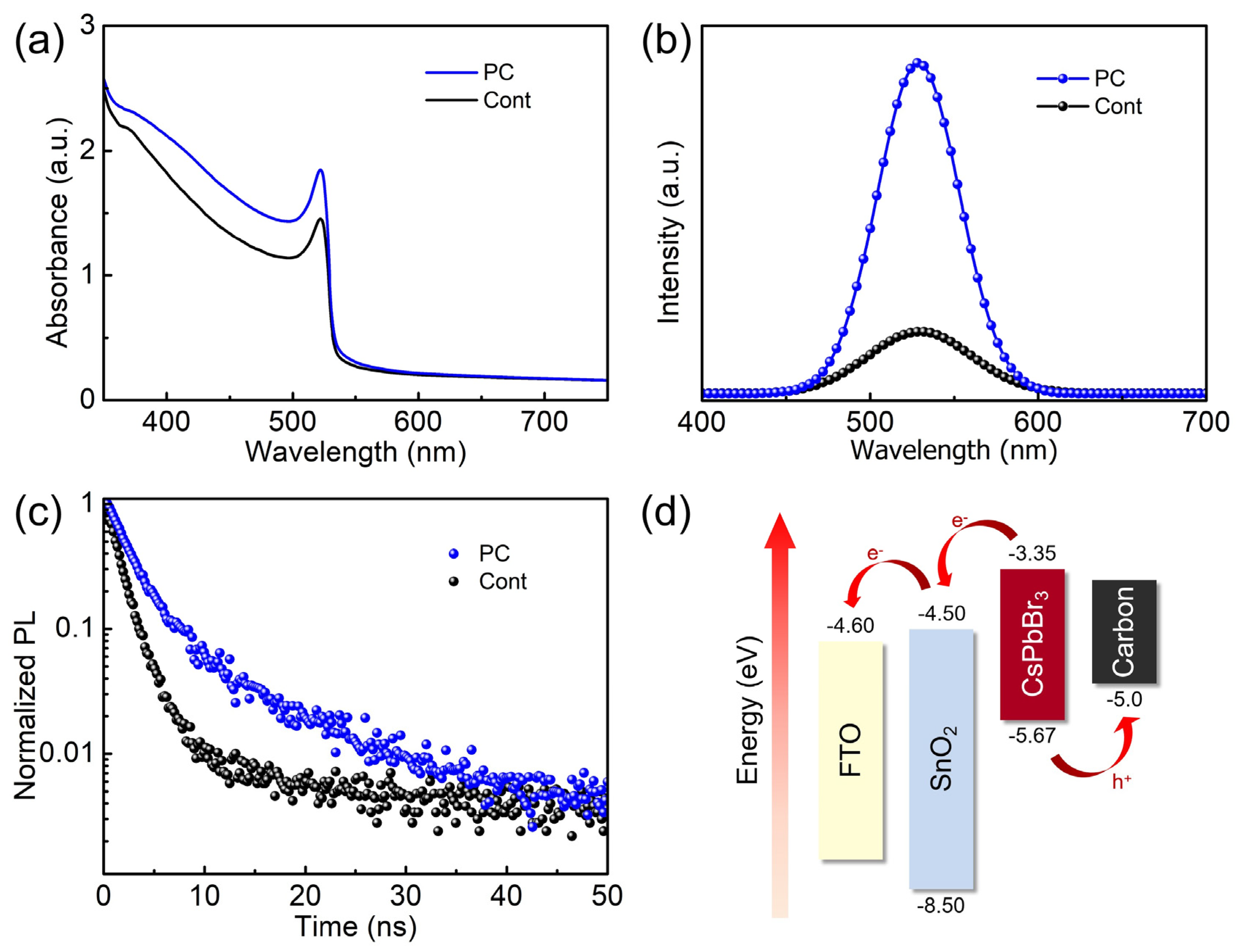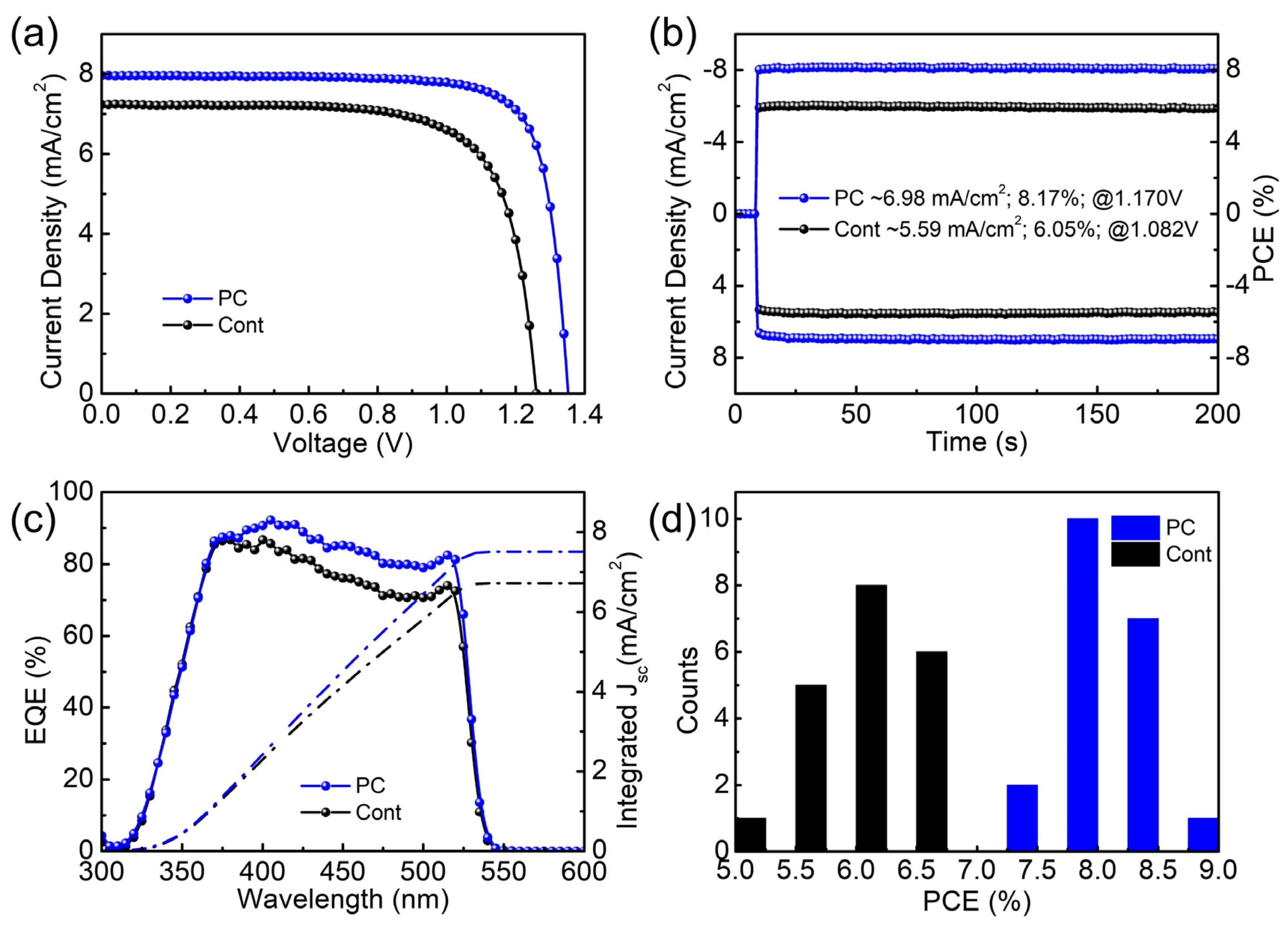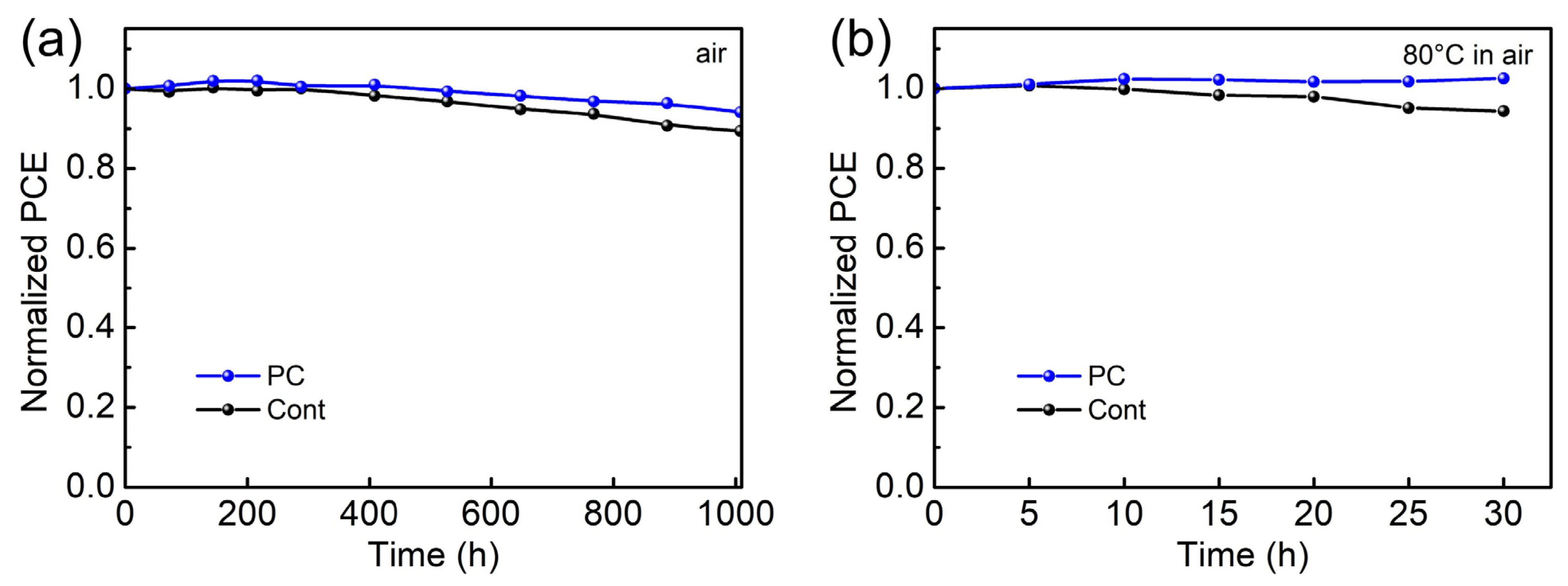Preparation of Highly Efficient and Stable All-Inorganic CsPbBr3 Perovskite Solar Cells Using Pre-Crystallization Multi-Step Spin-Coating Method
Abstract
1. Introduction
2. Experimental Details
2.1. Materials
2.2. Solution Preparation
2.3. Device Fabrication
2.4. Device Characterizations
3. Results and Discussion
4. Conclusions
Supplementary Materials
Author Contributions
Funding
Institutional Review Board Statement
Informed Consent Statement
Data Availability Statement
Acknowledgments
Conflicts of Interest
References
- Kojima, A.; Teshima, K.; Shirai, Y.; Miyasaka, T. Organometal halide perovskites as visible-light sensitizers for photovoltaic cells. J. Am. Chem. Soc. 2009, 131, 6050–6051. [Google Scholar] [CrossRef] [PubMed]
- Zhou, J.; Tan, L.; Liu, Y.; Li, H.; Liu, X.; Li, M.; Wang, S.; Zhang, Y.; Jiang, C.; Hua, R.; et al. Highly efficient and stable perovskite solar cells via a multifunctional hole transporting material. Joule 2014, 8, 1691–1706. [Google Scholar] [CrossRef]
- Heo, D.Y.; Lee, T.H.; Iwan, A.; Kavan, L.; Omatova, M.; Majkova, E.; Kamarás, K.; Jang, H.W.; Kim, S.Y. Effect of lead thiocyanate ions on performance of tin-based perovskite solar cells. J. Power Sources 2022, 458, 228067. [Google Scholar] [CrossRef]
- Tian, X.; Stranks, S.D.; You, F. Life cycle assessment of recycling strategies for perovskite photovoltaic modules. Nat. Sustain. 2021, 4, 821–829. [Google Scholar] [CrossRef]
- Yang, Y.; You, J. Make perovskite solar cells stable. Nature 2017, 544, 155–156. [Google Scholar] [CrossRef] [PubMed]
- Wang, L.; Shahiduzzaman, M.; Muslih, E.Y.; Nakano, M.; Karakawa, M.; Takahashi, K.; Tomita, K.; Nunzi, J.M.; Taima, T. Double-layer CsI intercalation into an MAPbI3 framework for efficient and stable perovskite solar cells. Nano Energy 2021, 86, 106135. [Google Scholar] [CrossRef]
- Liu, Q.; Qiu, J.; Yan, X.; Fei, Y.; Qiang, Y.; Chang, Q.; Wei, Y.; Zhang, X.; Tian, W.; Jin, S.; et al. Surface passivation and hole extraction: Bifunctional interfacial engineering toward high-performance all-inorganic CsPbIBr2 perovskite solar cells with efficiency exceeding 12%. J. Energy Chem. 2022, 74, 387–393. [Google Scholar] [CrossRef]
- Qiu, J.; Mei, X.; Zhang, M.; Wang, G.; Zou, S.; Wen, L.; Huang, L.; Hua, Y.; Zhang, X. Dipolar Chemical Bridge Induced CsPbI3 Perovskite Solar Cells with 21.86 % Efficiency. Angew. Chem. Int. Ed. 2024, 63, e202401751. [Google Scholar] [CrossRef]
- Wang, Z.; Tian, Q.; Zhang, H.; Xie, H.; Du, Y.; Liu, L.; Feng, X.; Najar, A.; Ren, X.; Liu, S. Managing Multiple Halide-Related Defects for Efficient and Stable Inorganic Perovskite Solar Cells. Angew. Chem. Int. Ed. 2023, 62, e202305815. [Google Scholar] [CrossRef]
- Cheng, J.; Fan, Z.; Dong, J. Research Progress of Green Solvent in CsPbBr3 Perovskite Solar Cells. Nanomaterials 2023, 13, 991. [Google Scholar] [CrossRef]
- Sutton, R.J.; Eperon, G.E.; Miranda, L.; Parrott, E.S.; Kamino, B.A.; Patel, J.B.; Hörantner, M.T.; Johnston, M.B.; Haghighirad, A.A.; Moore, D.T.; et al. Bandgap-tunable cesium lead halide perovskites with high thermal stability for efficient solar cells. Adv. Energy Mater. 2016, 6, 1502458. [Google Scholar] [CrossRef]
- Wei, L.; Rothmann, M.U.; Liu, A.; Wang, Z.; Zhang, Y.; Pascoe, A.R.; Lu, J.; Jiang, L.; Chen, Y.; Huang, F.; et al. Phase segregation enhanced ion movement in efficient inorganic CsPbIBr2 solar cells. Adv. Energy Mater. 2017, 7, 1700946. [Google Scholar] [CrossRef]
- Duan, J.; Zhao, Y.; He, B.; Tang, Q. High-purity inorganic perovskite films for solar cells with 9.72% efficiency. Angew. Chem. Int. Ed. 2018, 57, 3787–3791. [Google Scholar] [CrossRef] [PubMed]
- Liang, J.; Wang, C.; Wang, Y.; Xu, Z.; Lu, Z.; Ma, Y.; Zhu, H.; Hu, Y.; Xiao, C.; Yi, X.; et al. All-inorganic perovskite solar cells. J. Am. Chem. Soc. 2016, 138, 15829–15832. [Google Scholar] [CrossRef]
- Zhu, J.; Tang, M.; He, B.; Shen, K.; Zhang, W.; Sun, X.; Sun, M.; Chen, H.; Duan, Y.; Tang, Q. Ultraviolet filtration and defect passivation for efficient and photostable CsPbBr3 perovskite solar cells by interface engineering with ultraviolet absorber. Chem. Eng. J. 2021, 404, 126548. [Google Scholar] [CrossRef]
- Liang, K.; Wu, Y.; Zhen, Q.; Zou, Y.; Zhang, X.; Wang, C.; Shi, P.; Zhang, Y.; Sun, W.; Li, Y.; et al. Solvent vapor annealing-assisted mesoporous PbBr2 frameworks for high-performance inorganic CsPbBr3 perovskite solar cells. Surf. Interfaces 2023, 37, 102707. [Google Scholar] [CrossRef]
- Cao, X.; Zhang, G.; Su, G.; Zhang, H.; Song, W.; Xie, X.; Wang, Y.; Zeng, Q.; He, X.; Wei, J. Fabrication of large columnar grains composed CsPbBr3 films for efficient solar cells through ligand engineering. Colloids Surf. A Physicochem. Eng. Asp. 2023, 674, 131817. [Google Scholar] [CrossRef]
- Zhao, Y.; Wang, S.; Ran, H.; Zhang, Y.; Tang, Y. Two-in-one additive engineering strategy induced high-quality CsPbBr3 film in printable mesoscopic perovskite solar cells. J. Alloys Compd. 2023, 965, 171317. [Google Scholar] [CrossRef]
- Che, G.; Wang, X.; Cui, C.; Pang, B.; Wang, X.; Dong, H.; Feng, J.; Yu, L.; Dong, L. Boosting the efficiency and stability of CsPbBr3 perovskite solar cells through modified multi-step spin-coating method. J. Alloys Compd. 2023, 969, 172423. [Google Scholar] [CrossRef]
- Chi, K.; Zhai, Y.; Wang, Y.; Zhang, X.; Liang, F.; Wang, S. Porous PbBr2 films modulation by indium tribromide additive for the fabrication of SnO2-based CsPbBr3 perovskite solar cells. Ceram. Int. 2024, 50, 28386–28393. [Google Scholar] [CrossRef]
- Liu, X.; Tan, X.; Liu, Z.; Ye, H.; Sun, B.; Shi, T.; Tang, Z.; Liao, G. Boosting the efficiency of carbon-based planar CsPbBr3 perovskite solar cells by a modified multistep spin-coating technique and interface engineering. Nano Energy 2019, 56, 184–195. [Google Scholar] [CrossRef]
- Liu, X.; Liu, Z.; Tan, X.; Ye, H.; Sun, B.; Xi, S.; Shi, T.; Tang, Z.; Liao, G. Novel antisolvent-washing strategy for highly efficient carbon-based planar CsPbBr3 perovskite solar cells. J. Power Sources 2019, 439, 227092. [Google Scholar] [CrossRef]
- Yan, J.; Hou, S.; Li, X.; Dong, J.; Zou, L.; Yang, M.; Xing, J.; Liu, H.; Hao, H. Preparation of highly efficient and stable CsPbBr3 perovskite solar cells based on an anti-solvent rinsing strategy. Sol. Energy Mater. Sol. Cells 2022, 234, 111420. [Google Scholar] [CrossRef]
- Chen, D.; He, Y.; Fan, G.; Zhang, Z.; Zhu, W.; Xi, H.; Zhou, L.; Zhang, C.; Zhang, J.; Hao, Y. Ultrahigh fill-factor all-inorganic CsPbBr3 perovskite solar cells processed from two-step solution method and solvent additive strategy. J. Mater. 2023, 9, 717–724. [Google Scholar] [CrossRef]
- Zhang, Y.; Jiang, Z.; Zhang, W.; Yan, L.; Lu, C.; Ni, C. Pre-crystallization applied in two-step spin-coating method for high-quality perovskite films in photovoltaic devices. J. Alloys Compd. 2020, 832, 153616. [Google Scholar] [CrossRef]
- Zhao, Y.; Duan, J.; Wang, Y.; Yang, X.; Tang, Q. Precise stress control of inorganic perovskite films for carbon-based solar cells with an ultrahigh voltage of 1.622 V. Nano Energy 2020, 67, 104286. [Google Scholar] [CrossRef]
- Liu, J.; Zhu, L.; Xiang, S.; Wei, Y.; Xie, M.; Liu, H.; Li, W.; Chen, H. Growing high-quality CsPbBr3 by using porous CsPb2Br5 as an intermediate: A promising light absorber in carbon-based perovskite solar cells. Sustain. Energy Fuels 2019, 3, 184–194. [Google Scholar] [CrossRef]
- Teng, P.; Han, X.; Li, J.; Xu, Y.; Kang, L.; Wang, Y.; Yang, Y.; Yu, T. Elegant Face-Down Liquid-Space-Restricted Deposition of CsPbBr3 Films for Efficient Carbon-Based All-Inorganic Planar Perovskite Solar Cells. ACS Appl. Mater. Interfaces 2018, 10, 9541. [Google Scholar] [CrossRef] [PubMed]
- Luo, J.; Jia, C.; Wan, Z.; Han, F.; Zhao, B.; Wang, R. The novel dopant for hole-transporting material opens a new processing route to efficiently reduce hysteresis and improve stability of planar perovskite solar cells. J. Power Sources 2017, 342, 886–895. [Google Scholar] [CrossRef]
- Cao, X.; Zhang, G.; Cai, Y.; Jiang, L.; Chen, Y.; He, X.; Zeng, Q.; Jia, Y.; Xing, G.; Wei, J. Enhanced performance of CsPbBr3 perovskite solar cells by reducing the conduction band offsets via a Sr-modified TiO2 layer. Appl. Surf. Sci. 2020, 529, 147119. [Google Scholar] [CrossRef]
- Liu, X.; Liu, Z.; Ye, H.; Tu, Y.; Sun, B.; Tan, X.; Shi, T.; Tang, Z.; Liao, G. Novel efficient C60-based inverted perovskite solar cells with negligible hysteresis. Electrochim. Acta 2018, 288, 115–125. [Google Scholar] [CrossRef]
- Duan, J.; Zhao, Y.; Yang, X.; Wang, Y.; He, B.; Tang, Q. Lanthanide ions doped CsPbBr3 halides for HTM-free 10.14%-efficiency inorganic perovskite solar cell with an ultrahigh open-circuit voltage of 1.594 V. Adv. Energy Mater. 2018, 8, 1802346. [Google Scholar] [CrossRef]
- Saliba, M.; Etgar, L. Current density mismatch in perovskite solar cells. ACS Energy Lett. 2020, 5, 2886–2888. [Google Scholar] [CrossRef]
- Wang, S.; Wang, P.; Chen, B.; Li, R.; Ren, N.; Li, Y.; Shi, B.; Huang, Q.; Zhao, Y.; Grätzel, M.; et al. Suppressed recombination for monolithic inorganic perovskite/silicon tandem solar cells with an approximate efficiency of 23%. eScience 2022, 2, 339–346. [Google Scholar] [CrossRef]
- Wang, D.; Li, W.; Du, Z.; Li, G.; Sun, W.; Wu, J.; Lan, Z. Highly efficient CsPbBr3 planar perovskite solar cells via additive engineering with NH4SCN. ACS Appl. Mater. Interfaces 2020, 12, 10579–10587. [Google Scholar] [CrossRef] [PubMed]
- Hauff, E.; Klotz, D. Impedance spectroscopy for perovskite solar cells: Characterisation, analysis, and diagnosis. J. Mater. Chem. C 2022, 10, 742–761. [Google Scholar] [CrossRef]
- Cao, X.; Zhang, G.; Jiang, L.; Cai, Y.; Wang, Y.; He, X.; Zeng, Q.; Chen, J.; Jia, L.; Wei, J. Achieving environment-friendly production of CsPbBr3 films for efficient solar cellsviaprecursor engineering. Green Chem. 2021, 23, 2104–2112. [Google Scholar] [CrossRef]
- Fu, Z.; Xu, M.; Sheng, Y.; Yan, Z.; Meng, J.; Tong, C.; Li, D.; Wan, Z.; Ming, Y.; Mei, A.; et al. Encapsulation of Printable Mesoscopic Perovskite Solar Cells Enables High Temperature and Long-Term Outdoor Stability. Adv. Funct. Mater. 2019, 29, 1809129. [Google Scholar] [CrossRef]






| Device | Jsc (mA/cm2) | Voc (V) | FF | PCE (%) | |
|---|---|---|---|---|---|
| None | Average | 7.01 ± 0.72 | 1.210 ± 0.073 | 0.723 ± 0.041 | 5.97 ± 0.80 |
| Champion | 7.25 | 1.260 | 0.741 | 6.77 | |
| PC | Average | 7.66 ± 0.52 | 1.292 ± 0.063 | 0.787 ± 0.029 | 7.93 ± 0.69 |
| Champion | 7.96 | 1.351 | 0.802 | 8.62 |
Disclaimer/Publisher’s Note: The statements, opinions and data contained in all publications are solely those of the individual author(s) and contributor(s) and not of MDPI and/or the editor(s). MDPI and/or the editor(s) disclaim responsibility for any injury to people or property resulting from any ideas, methods, instructions or products referred to in the content. |
© 2024 by the authors. Licensee MDPI, Basel, Switzerland. This article is an open access article distributed under the terms and conditions of the Creative Commons Attribution (CC BY) license (https://creativecommons.org/licenses/by/4.0/).
Share and Cite
Zhang, Y.; Jiang, Z.; Li, J.; Meng, G.; Guo, J.; Zhang, W. Preparation of Highly Efficient and Stable All-Inorganic CsPbBr3 Perovskite Solar Cells Using Pre-Crystallization Multi-Step Spin-Coating Method. Coatings 2024, 14, 918. https://doi.org/10.3390/coatings14070918
Zhang Y, Jiang Z, Li J, Meng G, Guo J, Zhang W. Preparation of Highly Efficient and Stable All-Inorganic CsPbBr3 Perovskite Solar Cells Using Pre-Crystallization Multi-Step Spin-Coating Method. Coatings. 2024; 14(7):918. https://doi.org/10.3390/coatings14070918
Chicago/Turabian StyleZhang, Yulong, Zhaoyi Jiang, Jincheng Li, Guanxiong Meng, Jiajun Guo, and Weijia Zhang. 2024. "Preparation of Highly Efficient and Stable All-Inorganic CsPbBr3 Perovskite Solar Cells Using Pre-Crystallization Multi-Step Spin-Coating Method" Coatings 14, no. 7: 918. https://doi.org/10.3390/coatings14070918
APA StyleZhang, Y., Jiang, Z., Li, J., Meng, G., Guo, J., & Zhang, W. (2024). Preparation of Highly Efficient and Stable All-Inorganic CsPbBr3 Perovskite Solar Cells Using Pre-Crystallization Multi-Step Spin-Coating Method. Coatings, 14(7), 918. https://doi.org/10.3390/coatings14070918





